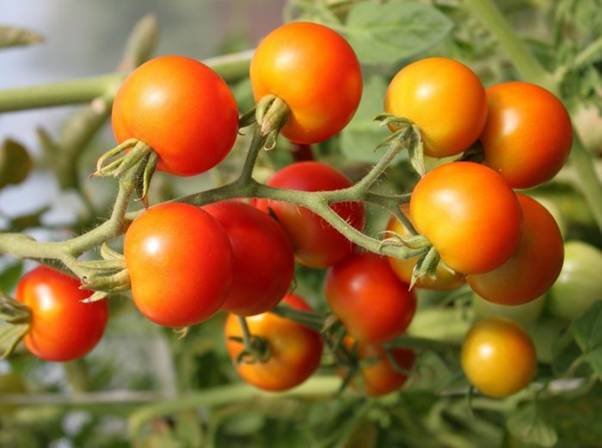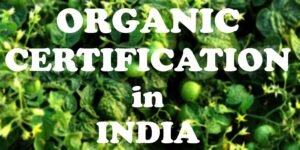High yield Organic Tomato Information Guide?
Organic Production of Tomatoes
Tomato or Solanum lycopersicum is a berry belonging to the Solanaceae family of genus lycopersicon and it has originated in the Western South American region and the cultivation has started by the people of Mexico. In general, it is a fruit or a berry that consists of an ovary along with seeds of the flowering plant.
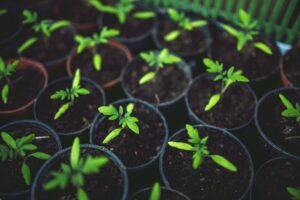
How to Take Organic Certification In India?
The largest producer of tomatoes in the world is China and it is followed by India which ranks second in the Tomato production. It has been estimated that the overall tomato production in the world is around 1300 lakh tonnes with Brazil having the highest area under tomato cultivation with 61,000 hectares of land.
In India, Andhra Pradesh is the leading producer of tomatoes with an approximate 15 lakh tonnes production annually and Orissa having the largest area for tomato production with 100 thousand hectares of land.
Tomato is a short duration crop, so the farmers grow three or four crops in a year and it offers them great employment on a larger scale because these vegetable crops are also labour intensive and they can also adopt a different type of cropping patterns with these crops.
Tomato is one of the most profitable crops of India and its commercial cultivation can make a profitable agribusiness because this vegetable can be produced throughout the year and it has a huge demand in both the local and international market.
We’ve already provided the general cultivation of tomatoes. In this article, we will discuss growing them organically.
Best Farming Methods For Tomato.
Organic Cultivation of Tomatoes
Organic Agriculture requires proper farm design and Management so that it could achieve sustainable productivity without using any type of artificial or external inputs like chemical fertilisers or pesticides.
You should not produce any type of chemical residues and the development of a tomato should be environment friendly and the application of different farming methods should restore and maintain the fertility of soil.

This requires proper selection of plants, crop rotation, recycling of plant and animal residues, proper tillage, and water management.
In general, organic farm products are more expensive than inorganic crops and the yielding takes more time as compared to the inorganic crops. The various requirements for organic farming are:
Difference between Organic Farming & Sustainable Farming.
- Crop Rotation – Crop rotation is one of the major components of organic farming because it affects the soil conditions and pest cycles. If the tomato crop is rotated with non solanaceous crops like pulses or legumes, it helps in avoiding pests and diseases which affect the tomato and it also helps in increasing the nitrogen status of the soil.
- Soil Fertility – The soil should be kept fertile by regularly adding organic matter into it and if your land has been into organic farming for many years, then the soil must have a good nutrient content. Just make sure that you rotate tomatoes with legumes at least once every few years, so that the nitrogen content remains and you can even add compost, barnyard manure and poultry litter for further enriching of the soil.
- Planting Material – Tomatoes are generally propagated by seeds and the seeds are selected properly. For raising nurseries, high yielding varieties of seeds are selected so they could tolerate different pests and diseases. They are carefully selected from certified organic farms or from their seed plot which is raised organically. In the absence of organically produced seeds, you can also start with chemically untreated seeds from the local high yielding tomato
How To Make Organic Jeevamutha?
Soil Preparation
Tomatoes can be grown on various soil types but it grows best in deep soil having plenty of space for their roots. The ideal soil is loamy or sandy loam soil. Clayey soil should be avoided and if you use clay soil, amend it with sand, Coco coir or peat moss so as to develop drainage and texture.
The soil should be rich in compost and organic matter and should have a good moisture retention and drainage quality.

The soil should be combined with cover crops, green manures, compost and rock minerals for the high yielding of tomatoes. It generally prefers slightly acidic soils with a pH level of 6.0 to 6.8 and if you are growing on Sandy soils, warm it during the spring season for early fruit production.
Varieties of Tomatoes for Organic Production
Open pollinated varieties (OPV) are generally preferred for organic farming of tomatoes. Some of the local varieties like Swarna Lalima and Swarna Naveen are generally suitable for it. Lakshmi NP 5005 is popular in the state as it can resist bacterial wilt and leaf mosaic virus.
Seed Rate & Treatment in Organic Production
Complete Guide For Organic Vegetable Farming.
In a nursery bed, about 300 to 400 gram per hectare of seeds are required. Hybrid seeds are generally costly so they are sown in plastic cups or Ice cube trays which require 70-90 g of the seeds.
The seeds are treated with Trichoderma @ 5 to 10 gram per kg seed or with Carbendazim @ 2 gram per kg of seed, for avoiding damping off disease. These treated seeds are then dried in a shade for 30 minutes and then sown sparsely along the lines with a depth of 0.5 cm and is then covered by the topsoil.
Spacing of Tomatoes
The recommended spacing is 75 × 60 cm for autumn – winter crop and 75 × 45 cm for spring – summer crop.
Irrigation Management in Tomatoes Production
Details of Drip Irrigation System.
The water requirement varies with the climate, soil type and plant size. On average, tomatoes use 1 to 1.2 inches of water weekly and the irrigation system used for tomato production contains surface and furrow flooding, overhead sprinklers, Drip or trickle irrigation.
Flooding is generally used for large-scale plantings so sprinkler irrigation is generally used but you should remember that excess water could increase the risk of diseases.
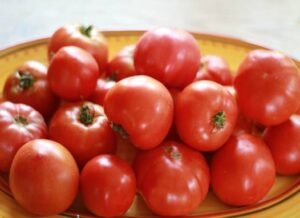
Drip irrigation efficiently supplies the needed moisture directly and at a constant rate as compared to overhead irrigation systems but the material and labour costs are higher for drip irrigation. Tomatoes require an even supply of moisture throughout their growing stage.
Irrigation should be provided at every 5 to 7 days interval during summer and 10-15 days interval during winters. After heavy watering, drought can cause cracking of tomato fruits so it should be avoided.
Fertiliser Requirement
Tomatoes require organic fertilisers during certain stages of their growth depending upon the plant nutrients that are available in the soil. Some of the organic natural tomato fertilisers are:
- Compost – The compost produces rich and pure organic matter that contains necessary nutrients and beneficial microbes. It has all the basic nutrients that are absent in synthetic fertilisers. It helps in fertilising tomatoes and also retains the soil nutrients and water, neutralising the soil, and adding beneficial microorganism to the soil.
- Epsom salt – It helps the tomatoes with the necessary magnesium which makes the flower bloom and the plants stronger, more tomato fruit production with a deeper green colour along with taste but it is recommended to cover the Epsom salt with a thin layer of dirt before placing the tomato seedling in the hole.
- Fish Emulsion – Fish emulsion is a natural, concentrated water soluble liquid fertiliser for providing an extra boost during the transplanting and growing stage which is made by blending different parts of the fish including bones.
- Organic Cottonseed Meal – Ot is a natural fertiliser that is added as an organic soil amendment during the time of transplanting the seedlings. This fertiliser is rich in Potassium, Nitrogen and Phosphorus and the high level of Nitrogen supports the foliage growth during the early stages of plant growth.
How To Do Fertigation With Drip Irrigation System?
Some of the Vegetable fertilisers are:
- Alfalfa Meal – This fertiliser contains a good amount of micronutrients and useful hormones along with Nitrogen, Phosphorus and Potassium. The tomatoes planted in compost and dressed with alfalfa mulch cover grows well and it helps in reducing the moisture loss because of evaporation.
- Seaweed – These are generally low in Nitrogen, Phosphorus and Potassium content, but it has over 60 types of trace elements which are crucial for the fruit formation.
The organic fertiliser improves the soil fertility and they release the nutrients gradually and therefore last longer in soil and is available in both granular and liquid forms but the three major contents i.e Nitrogen, Phosphorus and Potassium are not balanced and if the fertiliser is not properly composted, it can have damaging pathogens and sometimes if the fertiliser is not strong enough, it can increase your expenses.
Intercultural Practises
Just after 4 to 5 weeks of transplanting the tomato seedlings, the weeds start to grow, therefore, during this period, extensive weed control should be performed and the weeds should not be allowed to grow in numbers.
Organic weed control can be achieved by performing Crop rotation, Mulching, Sanitation and Shallow tilling.
After transplantation, regular weeding is important so as to remove the harmful weeds from the field and the tomato plants should be provided with support using bamboo sticks to increase their production.
How can you produce vermi compost?
Organic Pest & Disease Control
Tomato plants when grown organically, they have fewer pest and insect problems as compared to the conventionally grown plants and if a proper crop rotation is practised, the life cycle of the insect and pest is broken, so you have a smaller pest menace.
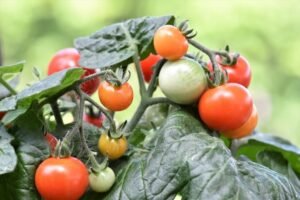
For controlling the pests effectively, trap crops can be used such as sweet corn as it attracts tomato fruit worms thereby protecting the crop when it is inter planted with tomato.
Synthetic fungicides, weedicides and pesticides are prohibited in organic farming, therefore, natural enemies of the pests are grown. For controlling the weeds, a manual weeding process is done.
Plant based repellents like Neem seed kernel extract, mechanical traps, pheromone traps, clay, softsoap and chromatic traps are permitted for using it in the organic farms and if there is an absolute necessity you can consult the certifying agency and can use the products such as mineral oils like kerosene, plant and animal preparations and Bordeaux mixture as well.
Increasing Role of Bio Fertilizer in India.
Some of the organic insecticides like Neem fertilisers can also be used for clearing the common pests and diseases of the tomato plant. You can also use organic Seaweed fertilisers for promoting more fruit in the plant.
Fungal diseases like Powdery mildew can be prevented by spraying a mixture of baking soda and potassium bicarbonate along with horticulture oil and water. You can even use milk by mixing 1 part of milk to 9 parts of water.
Cornmeal is also used for fungal infections by mixing one cup of cornmeal with 5 gallons of water, which is then strained and sprayed on the plants.
Harvesting & Yield
Tomato can be harvested within 2-3 months after plantation and in general 8-10 harvesting is done every year depending upon the market demand. The first harvesting usually starts in 75 to 90 days after plantation and thereafter it is harvested as follows:
How to do Intercropping in Orgnic Agriculture?
- Green stage – When the tomato fruits are to be sent to a long distant market, then it is harvested at the maturity stage with green colour.
- Pink stage – The tomatoes are harvested when the colour changes from Green to pink and it is sent to nearby markets.
- Maturity stage – When the tomatoes are to be sold in the local market, the harvesting is done when the fruit is reddish in colour.
- Full maturity – When the fruit is slightly red and fully reddish on the tree, it is harvested and these fruits are generally harvested for making durable materials such as ketchup, sauce, soup, chutney etc.
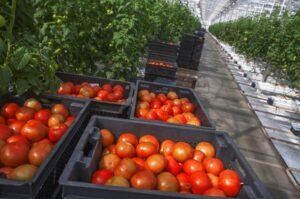
On an average, tomato crop yields about 10 tons per acre in India, whereas the yielding varies from 15 to 20 tons per acre in case of irrigated crops.

